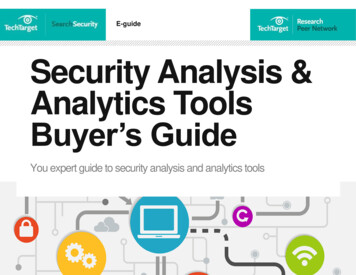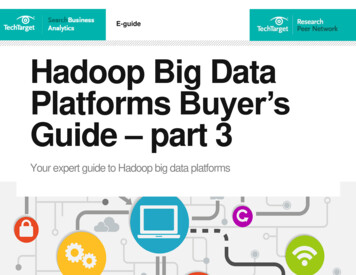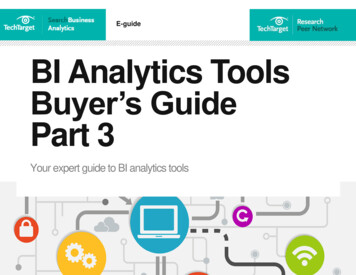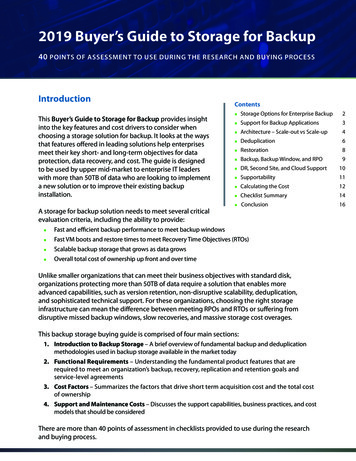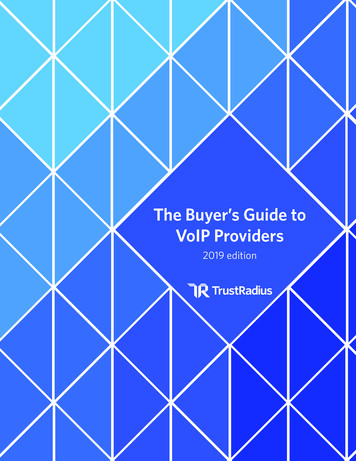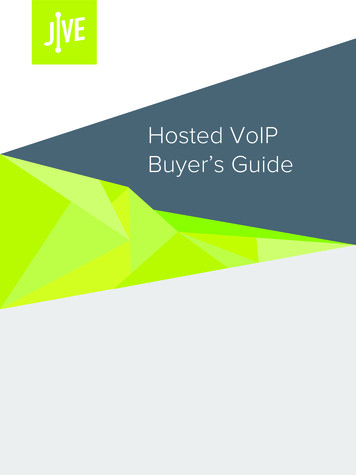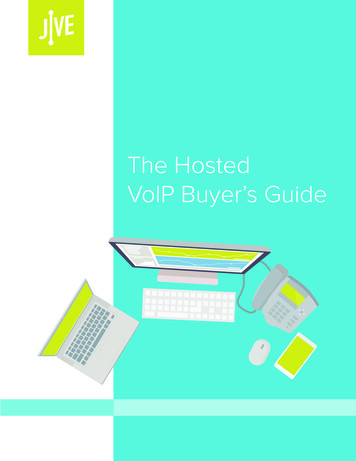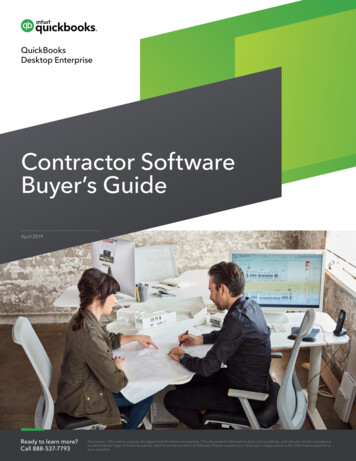
Transcription
QuickBooksDesktop EnterpriseContractor SoftwareBuyer’s GuideApril 2019Ready to learn more?Call 888-537-7793Disclaimer: Information may be abridged and therefore incomplete. This document/information does not constitute, and should not be considereda substitute for legal or financial advice. Each financial situation is different. Please contact your financial or legal advisors for information specific toyour situation.1
IntroductionIn just three years Southern Services & Equipment, a steel fabricationcontractor in New Orleans, went from 3 million to 12 million in revenue—a 294% three-year growth rate. This earned them a nod on the Inc.5000 list of fastest growing companies in America two years in a row.But SSE’s rise in revenue wasn’t without its growing pains.They took on plenty of new projects, but this meanttheir field personnel were always running from jobsite to job site. Some of these new projects startedabruptly after being delayed, so SSE had to wedgethem in along with their on-time projects. Theirfabrication facility was continually running at fullcapacity and employees were working overtimejust to keep jobs on schedule. As result, they didn’thave time to implement cost and overhead controls,which ate into their profits.Contractors often aren’t able to choose when theywant their business to grow. In the beginning, it’sall about survival, getting to a place where you canfinally come up for air. The truth is only 36% of construction companies make it to their fifth year.If you’re looking for culprits for construction company failures, the Surety Credit Survey for ConstructionContractors cited low profit margins, slow collections, and insufficient capital as the major causes offinancial difficulties among contractors.But let’s say your company is established, with asteady flow of projects and a few winning bids onbig projects, giving your company no choice but totake your operations to the next level. Only after youfind some time to take a deep breath can you ask, “Howcan I go from 10 million in revenue to 50 million? Or 25million to 100 million?”For contractor businesses who want to grow, but want to do it sustainably instead of chaotically, there’s an opportunity to start using thetools and systems that will not only support but also fuel that growth.Maybe job costing with Excel has become too unwieldy. Or you’ve hadan inkling some projects just aren’t profitable, but it’s been impossibleto prove it. Papering over underlying issues doesn’t make them goaway and can put a wrench in your hopes for sustainable growth.Contractor Software Buyer’s Guide2
Putting off creating systems to fix these problems can ruin the spoils ofsuccess when revenue grows exponentially. Correcting already knownissues during periods of tremendous growth is like trying to repair arocket during takeoff—it’ll likely end in disaster.This is how scaling up can result in overexpansion—all of the revenuegrowth without the accompanying profits. Here are a few commonreasons why contractor business growth doesn’t result in a healthierbottom line: Poor job cost tracking. Inadequate expense tracking tools can leadto missing job costs, which are the ghosts stealing profitabilityfrom your projects. Accurate job costing is a must for maintainingyour company’s margins. Inadequate cash flow management. U.S. Bank completed a studyfinding 82% of businesses fail because of cash flow issues. Goodcash flow management requires accurate financial projections toshow how much working capital is needed for operations, as wellas good collection processes for accounts receivable. Contractorsthat can’t look past their proverbial nose can regularly find themselves short of cash when they need it most. Lack of accounting best practices. Bad bookkeeping habits canbe hard to break. Yet accurate bookkeeping and precise financialstatements are key to maintaining your company’s financial health.Establishing proper accounting protocols can be the first step insolving nagging issues.If any of these problems are plaguing your business now, they can turninto major headaches down the road, pulling you away from winningbids and completing projects on time and under budget.For contractors looking to avoid these pitfalls and establish a solid infrastructure for growth, upgrading to a business management softwarewith the right mix of ease of use and enhanced capability can be thesecret sauce for taking your company to the next level.Business management software provides the data you need to managejobs effectively and make better financial decisions for the company. Italso gives you better control and clearer visibility with estimates, project costs, change orders, and bookkeeping, giving you an X-ray view ofyour company’s financial health. With control comes increased confidence in, enabling your company to focus on doing its best work.For those contractor businesses looking for a solution like this, thechoice usually comes down to best-in-breed business managementsoftware or an all-in-one ERP solution.Contractor Software Buyer’s Guide3
Best-In-Breed BusinessManagement Software vs.All-In-One ERPsEnterprise Resource Planning (ERP) software is sold as an all-in-onebusiness software solution that has powerful capabilities, but it alsocomes with expensive and unnecessary software modules for functionslike ecommerce, HR, and CRM.ERP software costs usually start at five figures, plus 1.5 to 2.5 times thesoftware cost for implementation. Implementing an ERP typically takes6 to 12 months. Then you have to factor in additional costs like: HardwareIntegrationTrainingMaintenance and upgradesActivation feesMindy Nunez Airhart, SSE’s CEO, once considered switching over to anERP after learning about their industry-specific software modules. Butwhen she asked an ERP salesperson how much implementation wouldcost, she was shocked, “When he said five figures I nearly fell out of mychair. I said, ‘No. It’s not happening.’”Five figures for ERP implementation is actually on the low end of thescale, as a typical ERP implementation can cost upwards of 150,000.A good rule of thumb is you’ll pay about 1.5 to 2.5 times the cost of thesoftware for implementation. One reason for ERPs lengthy implementation periods and costly software is it’s all-encompassing, touchingevery aspect of a business and changing the way it operates.Instead, business management software solutions provide best-inbreed financial tools with the ability to integrate with software yourcompany already uses, like Field Pulse, TSheets, and CoConstruct.Before you make a final decision, there are a few important things toconsider:Contractor Software Buyer’s Guide4
6 Questions to Ask BeforeBuying Contractor SoftwareChanging the software you use to run your company is a significantinitiative. It’s important to request input from all the necessary stakeholders early in the process, so they are invested in the process (thiscan also lead to higher adoption rates post-implementation). Whengathering feedback, be sure to ask these questions internally beforeyour software search.1. What jobs do you need your business management software to do?This can be a simple as making a list of wants and needs—which canvary based on your company’s niche. If field management is essentialto the way you run your business, put it on the list. Other features likejob costing, payroll, and project scheduling should all find their way onyour list of priorities. Established contractors looking to upgrade theirbusiness management software are typically in need of advanced reporting features—default report templates aren’t won’t cut it anymore.Imagine being able to unlock hidden insights so you canmake strategic decisions about where your businesscan grow. With full customization of every aspect ofyour reports, you can uncover these insights basedon the unique characteristics of your business. Plus,you’ll save precious time by cutting down on manual entry and reducing your risk of errors. Advancedreporting is what helps you stay on top of job costsand cash flow so you can ensure the profitability ofyour projects as you grow.When you start to consider solutions, you’ll have amuch easier time sorting through which is right foryour company if you know the jobs it needs to do.You’ll also be better able to spot excess softwaremodules or features so you don’t end up with bloated and expensive software.2. What are your weaknesses as a business andwhat do you need to get better at?This is a great opportunity to take an honest look atyour company and figure out what needs to changein order to meet your goals. Of course, softwarecan’t solve all business problems, but you don’t getmany chances to revamp the systems you use toContractor Software Buyer’s Guide5
run your company. Your search should involve looking for solutions toproblems that have been holding the company back.3. What are your one and five-year growth projections?When shopping for software, the focus tends to be on features andcosts. Another important and often overlooked consideration is theability of your business management software to grow with you. Thinkabout where you project your company to be in the next year to fiveyears. It’s important that your business management software can scalewith you, with a solution you can trust to have your back along the way.4. Do you want cloud-based or self-hosted software?Self-hosted software is a good fit for companies with existing IT infrastructure. They are more customizable than cloud-based software butrequire a costlier upfront investment due to higher hardware costs. Incontrast, cloud-based software is becoming the norm, with most business management software solutions offering cloud-based options.People are becoming more comfortable with having their data hostedon the cloud, but if data security is of utmost importance, then hostingyour data in-house may be your best option.5. Do you need business management software that supports you inthe field?A growing consideration for contractors is enabling their project management employees to effectively perform in the field. Today tasks likejob scheduling, real-time project updates, invoicing, and mobile expenses can all be done in the field, saving employees time and helpingadministrative staff operate more efficiently. With increased coordination amongst employees in the field, growing a business can feel lesslike total chaos and more like a challenge.6. What is your total budget for upgrading your business management software?Creating a comprehensive budget can be difficult, especially whenshopping for an ERP, because of the myriad costs that have to beaccounted for. Accurate pricing can also be difficult to find, requiringmultiple phone calls with different vendors. Remember, implementation typically costs about 1.5 to 2.5 times the cost of the software.In addition to standard costs like hardware, implementation, training,and maintenance, be sure to account for additional costs like licenses,customization, integration, and activation fees. In addition to a financialbudget, be sure to budget the proper amount of time and manpowerthat will be needed for the implementation and training period. We’vecreated a QuickBooks Enterprise pricing calculator to make budgetingmuch easier, giving you a total cost for your company in about a minute.Contractor Software Buyer’s Guide6
Smarter Business Tools,Better DecisionsDuring every phase of a project, a contractor needs to know it linesup with deadlines and cost estimates. For close to 20 years, SouthernServices & Equipment has used QuickBooks Enterprise to do this andmuch more—through the boom times and the lean times.As companies grow, running an efficient operation gets more difficultwith increased employee counts and bigger project loads. Choosinga business management software that gives you the visibility to makebetter business decisions is one of the best moves you can make toachieve sustainable growth as a company.Learn more about QuickBooks Enterprise here.Contractor Software Buyer’s Guide7
Contractor Software Buyer’s Guide QuickBooks Desktop Enterprise April 2019 Ready to learn more? Call 888-537-7793 Disclaimer: Information may be abridged and therefore incomplete. This document/information does not constitute, and should not be considered a substitute for legal or financial advice. Each financial situation is different. Please contact your financial or legal advisors for
